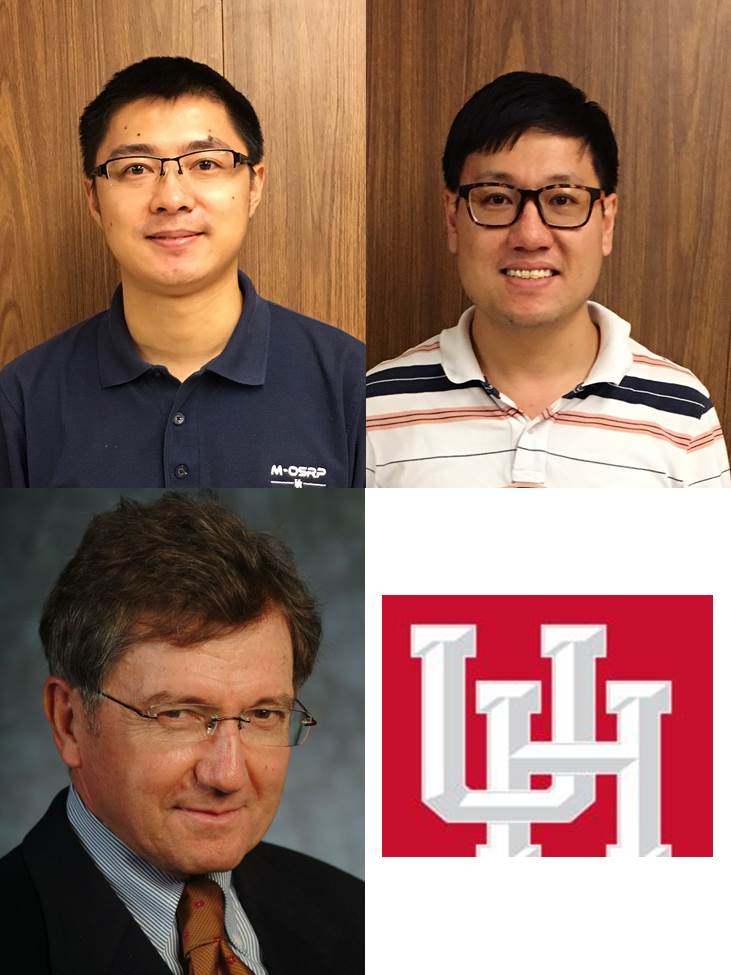Data Proc & Acqui SIG: The first multi-dimensional internal-multiple-elimination method: A new toolbox* ,,,-Oct 9th

Complete Title with Abstracts on event page
Event Location:
Schlumberger
Q Auditorium
10001 Richmond Avenue
Houston TX 77042 USA
NOTE: You Must be Logged in to Register
Speakers: Yanglei Zou, Chao Ma, and Arthur B. Weglein, M-OSRP/Physics Dept./ UH
Complete Title: The first multi-dimensional internal-multiple-elimination method: A new toolbox option for removing internal multiples that interfere with primaries, without damaging the primary, and without any knowledge of, and need for, subsurface information
We begin with a brief overview of M-OSRP projects and their approach to identifying and addressing pressing and prioritized seismic challenges. Within that broad perspective we focus on the project that progresses and delivers new and necessary capability and effectiveness for the removal of multiples. In seismic exploration, migration and migration-inversion are the methods to locate and identify targets and hydrocarbon reservoirs. Only primaries are migrated and migration-inverted. And primaries come in two varieties: those that are recorded and those that are not recorded. There are circumstances where a recorded multiple can be used to provide an approximate image of an unrecorded primary, where the latter is a subevent of the recorded multiple. The removal and using of multiples are not adversarial positions and viewpoints, but rather are addressing different issues and circumstances, and represent different levels of ambition, capability and effectiveness, as options within the seismic processing toolbox.
However, only recorded primaries can provide specular and non-specular structural imaging (e.g., for curved reflectors and pinch-outs) and subsequent amplitude analysis using the most effective and interpretable imaging and inversion method, Stolt CIII migration. The new Stolt CIII migration for heterogeneous media is the first migration method that is equally effective at all frequencies at the target and reservoir, and provides resolution benefits and added value (at the target and reservoir) that is beyond the intrinsic resolution capability of RTM and all variants and extensions of RTM. Stolt CIII migration inputs recorded primaries. For a smooth velocity model and Stolt CIII migration, multiples will produce false images and artifacts; therefore multiples must first be removed prior to migration and migration-inversion. Hence removing multiples remains a significant and important E&P objective, and obstacles to the effective removal of multiples are a prioritized and pressing challenge in many offshore and onshore plays.
This presentation will focus on certain serious obstacles and challenges to current multiple removal capability, and recent advances to address those challenges in removing internal-multiples. The Inverse-Scattering-Series (ISS) internal-multiple-attenuation algorithm (Araújo et al. (1994), Weglein et al. (1997) and Weglein et al. (2003)) has stand-alone capability since it is the only method that can predict all internal multiples with correct time and approximate amplitude without requiring any subsurface information. It makes none of the assumptions of other methods (e.g. stacking, FK filter, Radon transform, deconvolution and Feedback loop etc.) and is especially effective when the subsurface is complicated, complex and unknown. When internal multiples and primaries are isolated, the ISS internal multiple-attenuation algorithm is usually combined with an energy minimization adaptive subtraction to remove internal multiples. When internal multiples are proximal to and/or interfering with primaries or other events, the criteria of energy-minimization adaptive subtraction can fail. With interfering events, this failure of energy-minimization adaptive subtraction can lead to removing/damaging the target primary which is the worst possible outcome.
In this presentation, we provide the first multi-dimensional ISS internal-multiple-elimination algorithm that can predict both the correct time and the correct amplitude of internal multiples without any subsurface information. This is an important part of a three-pronged strategy proposed by (Weglein 2014). That provides an effective response to this challenge while retaining and adding to the strengths of the current ISS internal-multiple-attenuation algorithm. We provide this method as a new capability in the multiple-removal toolbox and a new option for circumstances when this type of capability is called for, indicated and necessary. 1-D and 2-D acoustic and elastic model data are used to examine, analyze and evaluate the new internal multiple removal capability. We will discuss open issues, significant remaining challenges and future plans.
The link below provides relevant references for this presentation.
http://www.mosrp.uh.edu/news/annual-meeting-2017
Speaker Biographies:
Yanglei Zou received a B.S. in physics from University of Science and Technology of China. He is currently a PhD student in seismic physics at the University of Houston, advised by Prof. Arthur B. Weglein. His research topics include: (1) developing more effective methods for multiple removal and (2) resolution comparisons between Reverse Time Migration (RTM) and the first migration method that is equally effective at all frequencies at the target. Yanglei Zou and colleagues proposed the first multi-dimensional ISS internal-multiple-elimination method that can predict both the correct time and amplitude of all first-order internal multiples. That provides the capability to remove internal multiples that interfere with primaries, without subsurface information, and without damaging the primary. This elimination method is more effective and more compute intensive than the current most capable internal-multiple removal method today used in industry (ISS internal-multiple attenuation plus adaptive subtraction). It is a new internal-multiple removal toolbox option for circumstances when this kind of capability is especially needed.
Yanglei and his colleagues ( Qiang Fu) demonstrated that all current migration methods make high frequency approximations, and that the new Stolt CIII migration had resolution benefit beyond RTM for the wedge model.
Chao Ma received a B.S. (2010) in Geophysics from China University of Petroleum (East China), and a Ph.D. (2016) in Physics from University of Houston. Currently he is a post-doctoral fellow at Mission-Oriented Seismic Research Program (M-OSRP) at University of Houston. His Ph.D. thesis focuses on extending the capability of the ISS internal multiple attenuator to allow both primaries and internal multiples as subevents, by including higher-order terms in the ISS that can accommodate and benefit from all events in the recorded data. The extended algorithm retains the unique advantage of the original algorithm (i.e., predicting internal multiples without any subsurface information) and it is more accurate in predicting internal multiples when there are many internal multiple generators in complex on-shore and off-shore plays. Chao Ma had several successful internships at Schlumberger and at PGS. Chao Ma worked on multiple removal research projects at Schlumberger and among the topics he progressed at PGS was the use of multiples to enhance imaging, providing an approximate image of an unrecorded primary.
This past year, Chao Ma helped reformulate the ISS direct depth imaging without a velocity model, as a migration operation, taking an important step from the Kristin field data viability demonstration, towards a tool box option.
Arthur B. Weglein received his PhD in physics from the City University of New York and then spent two years as a Robert Welsh Postdoctoral Fellow at the University of Texas at Dallas. He entered seismic petroleum research in 1978, first at Cities Service Oil Company Research Laboratory in Tulsa (1978-81) and Sohio Petroleum Company Research Laboratory in Dallas (1981-85). Weglein spent the next 15 years as a member of ARCO’s research staff. He spent a sabbatical year (1989-90) as visiting professor at the Federal University of Bahia, in Brazil, and three years (1990-94) as scientific advisor at Schlumberger Cambridge Research in Cambridge, England. In 2000, Weglein joined the University of Houston as the Robert Sheriff Chair in Geophysics . In 2002, Weglein was promoted to a University-wide chair, the Hugh Roy and Lillie Cranz Cullen Distinguished University Chair in Physics, with a joint professorship in the Department of Physics and the Department of Earth and Atmospheric Sciences. Weglein was the SEG Distinguished Lecturer in 2003, in 2008 he received the CCNY Townsend Harris Medal, and in 2010 the SEG Reginald Fessenden Award for contributions to seismic exploration. In 2016, Weglein was awarded the SEG’s highest honor, the Maurice Ewing Medal.
Time Schedule:
4:30 PM – sign-in, social time
5:00 PM – start of presentation
6:00 PM - close of meeting
THANK YOU TO OUR GENEROUS SPONSORS:

